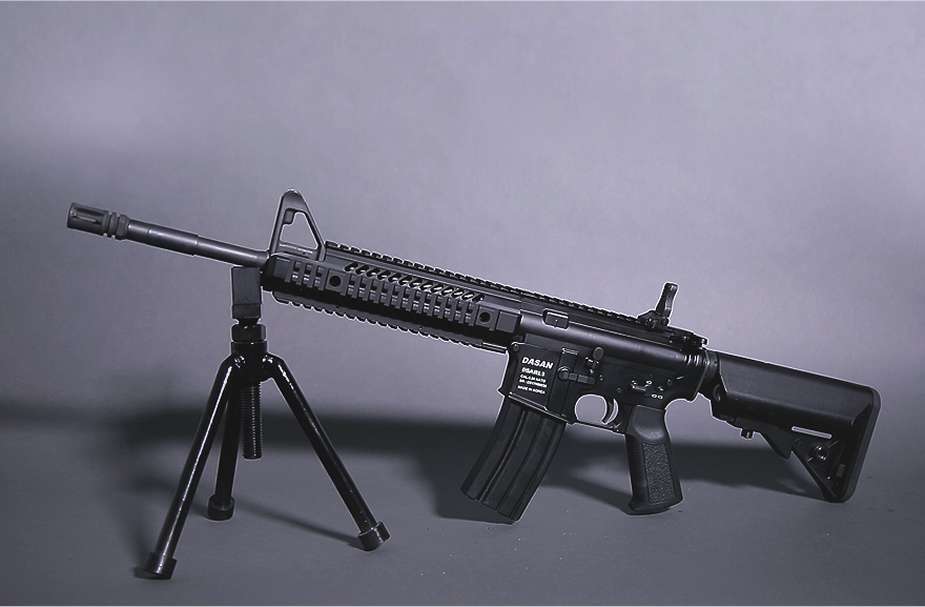Bangladesh has recently acquired South Korean Dsar-15 assault rifles to bolster its military arsenal. The Dsar-15, a South Korean assault rifle, is designated for the Bangladeshi naval forces. This acquisition also signifies South Korea's rising prominence as an arms supplier in the international market, offering competitive alternatives to traditional sources of military equipment.
Follow Army Recognition on Google News at this link

South Korean Dsar-15 assault rifles. (Picture source: Dasan)
South Korea has emerged as a major player in the global arms market, ranking among the top 10 arms exporters worldwide. This rise is due to a significant increase in global demand for arms, partly fueled by geopolitical conflicts and security concerns in various regions. In 2022, South Korea's arms exports reached a record $17.3 billion, a substantial increase from $7.25 billion in 2021. This growth was largely supported by major deals with countries such as Poland, which signed contracts worth $13 billion for South Korean military equipment in response to the ongoing conflict between Russia and Ukraine.
The Dsar-15 is an AR-15-type assault rifle, designed and manufactured by Dasan Machineries, a South Korean company. This weapon, a derivative of the Dsar-15P, is chambered in 5.56×45mm NATO caliber and operates with a short-stroke piston system and a rotating bolt. It has been selected by the Special Forces of the Republic of Korea as their future reference weapon.
The Dsar-15P, in particular, was chosen to replace the K1A 5.56 mm carbine used by the Special Warfare Command of the Republic of Korea Army (RoKA). This selection was made by the Defense Acquisition Program Administration (DAPA) of South Korea. Reports indicate that approximately 1,000 units of the unmodified Dsar-15PC are expected to be delivered to the 707 Special Mission Group and the 13th Special Mission Brigade of the Special Warfare Command, followed by the delivery of 15,000 improved rifles to all units of the command by 2023.
The Dsar-15PC, measuring 760 mm in length, combines some features of the AR-15 with a short-stroke gas piston system, similar to the Heckler & Koch HK416 5.66 mm rifle. It has an effective range of 550 meters and a firing rate of 700 to 950 rounds per minute. The rifle weighs 3 kg and its barrel measures 11.5 inches, making it suitable for close-quarter combat.
This rifle is equipped with a Picatinny rail mounted on top of the receiver, as well as on each side of the weapon and under the barrel, allowing the installation of various types of accessories such as panoramic sights, flashlights, laser sights, etc. It is chambered in 5.56x45 mm NATO caliber and uses a standard 30-round magazine. Three barrel lengths are available: 11.5 inches, 14.5 inches, and 16 inches. The Dsar-15P also features an ambidextrous 3-position safety selector and an adjustable buttstock with 6 positions.
One of the key factors behind South Korea's success in the arms export market is its ability to produce advanced and cost-effective military equipment, compatible with U.S. and NATO systems. This compatibility makes Korean weapons attractive to a diverse range of clients, including countries in Southeast Asia, the Middle East, and increasingly in Europe. The country's defense industry, led by companies such as Korea Aerospace Industries, Hyundai Rotem, and Hanwha Defense, has been instrumental in this export growth.
In terms of specific deals and expansions, South Korea has been proactive in reaching new markets and clients. For instance, Korea Aerospace Industries recently signed a contract to sell FA-50 light attack aircraft to Malaysia. Hanwha Aerospace's Redback infantry fighting vehicle was chosen as the preferred bidder for a major Australian acquisition program. The country is also exploring opportunities in the naval ship market, given its capabilities in building advanced submarines and Aegis-equipped destroyers.
However, despite these successes, South Korea faces challenges in maintaining and expanding its position in the global arms market. These challenges include the need for comprehensive financial packages to support large arms deals and the necessity to navigate complex geopolitical dynamics. For example, ongoing negotiations with Poland for additional military equipment sales highlight the need for financial support and political stability to secure such large-scale contracts.
South Korea's rise as a prominent arms exporter reflects its strategic positioning in the global market, leveraging its advanced military technology and the changing geopolitical landscape. This success, however, must be balanced with the challenges inherent in the global arms trade.
















